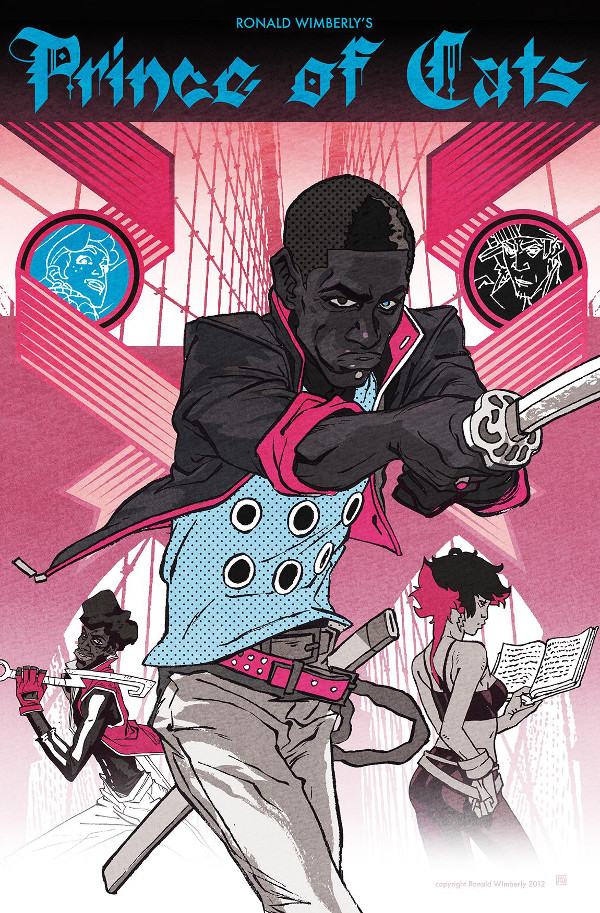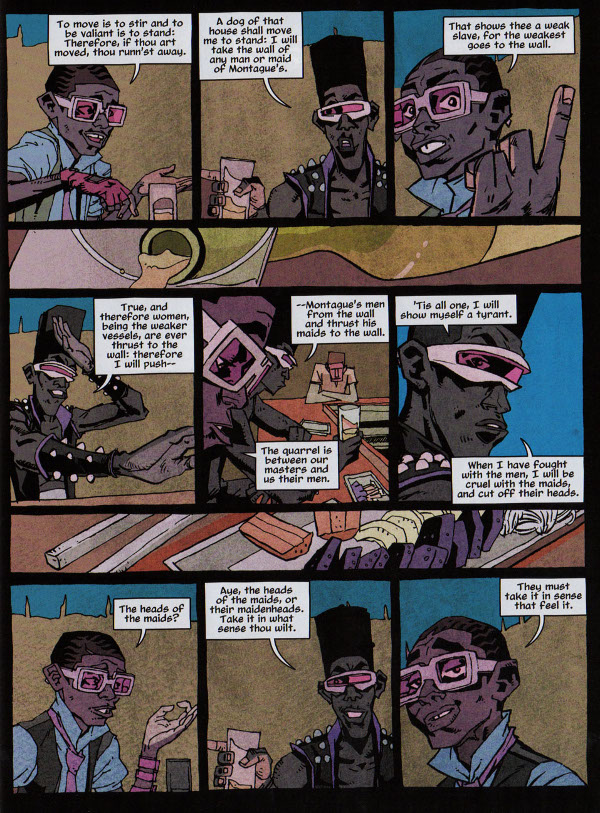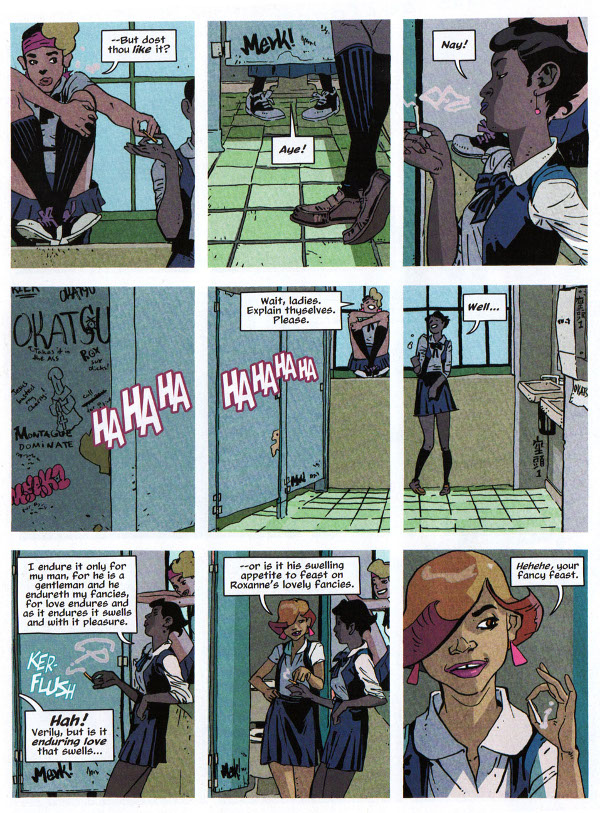Image Expo: Ronald Wimberly Talks the Return of Prince of Cats at Image
We often talk about the deluge of comics coming out these days and how that can be a good and a bad thing (depending on your perspective, really). For readers, having so many comics often means more diversity and a higher quality of releases (per Sturgeon’s Law), but it also can mean great books slip on by for many. One of those titles was the highly acclaimed graphic novel Prince of Cats by cartoonist Ronald Wimberly, which was originally released at Vertigo Comics in 2012. Despite towering acclaim from all who reviewed it and an exciting concept that retells William Shakespeare’s Romeo & Juliet in The Warriors era New York City, fusing NYC street culture and Japanese blades with star-crossed lovers (except through the prism of titular antagonist of the original story and comic – Tybalt), the book never found the audience it deserved and even went out of print by the following summer.
That’s less than ideal, which is why Wimberly looked to make a change when the rights to the book reverted back to him. Now, Wimberly is rereleasing the book at Image Comics – as per the announcement today at Image Expo in Seattle – with the idea that getting book back in print will mean finding a new audience. And in this writer’s estimation, he will, as Image is a far more fitting and supportive home for his work, and the marketplace is seemingly more ready for a graphic novel of this sort.
As part of the announcement, I talked with Wimberly about what happened with the book originally, why he decided to bring it back at Image, how he decided to fuse Shakespeare with that specific era of New York, why Tybalt was his lead, the progression of his career, his – my words – “Wimberlyverse,” and a bunch more. Give it a read, and look for this book soon from Image Comics.
It’s been almost four years since Prince of Cats was originally printed at Vertigo and three years since it went out of print. Before I get into the why you’re bringing it back into print somewhere else part, what’s the story behind it going out of print to begin with? And did the rights to the book simply revert to you after being out of print for a while?

Wimberly: Honestly, I wish I knew why it went out of print the first time. I found out when I tried to buy some copies from Forbidden Planet. I feel like it hadn’t quite been a year yet. It was out of print but mostly sold out as well. I was frustrated by the amount of people asking me where they could get it or why they couldn’t find it.
It was difficult because I didn’t understand how, given how well it seemed to perform and its critical reception, why it didn’t go back for a second printing. I’m still learning the business, so I can’t call it. I’d rather not imagine or guess as to why it was treated the way it was.
Well, I’ve been on top of getting the rights back since I found out that the book was out of print. I was lucky that Bob Mecoy, the agent I had at the time I sold the book to Vertigo, stayed on top of it. I was going mad waiting to initiate the reversion process.
So now Prince of Cats is coming back at Image. What made you want to bring it back into print, and what made Image the right place for it?
Wimberly: I wanted to bring it back because I thought the first printing of the book was mishandled. I want to get the book to anyone who never got a chance to get it the first time, and for people who loved it, I am happy to give them an opportunity to get the definitive copy, how it was intended, for their collection.
One thing that I think is really fascinating about the book is how it’s certainly its own flavor of Romeo & Juliet, which is a story we’ve seen adapted a lot. But, you know, never involving New York street culture, graffiti, Japanese blades nor, to my knowledge, having Tybalt as the lead. What made this a story you wanted to tell with your own flavor to it, and what made those elements something you wanted to weave into it?
Wimberly: Romeo and Juliet is probably the first Shakespeare most people see or read; it’s low hanging fruit as far as Shakespeare goes. When I first read it in high school, I thought it was some bullshit. I didn’t buy the way the kids were acting, but from adulthood, looking back on my youth, it made sense, and that scared me a bit. My imagination was sparked.
Shakespeare adapted many works, including, Romeo and Juliet for himself and his times, so it’s only natural, when adapting his works, to continue in that tradition. I also found some of the formal restraints of Shakespeare’s work were similar to the formal restraints of the artists working in eighties New York; I chose to play with these restraints.
Shakespeare broke apart and sampled older works; hip hop, a post modern narrative art born from the seventies, NY street culture, broke apart and sampled older and contemporary works as well. The emcee, who rhymes or “flows” over music often made of sampled, deconstructed, and repurposed audio, usually adheres to a rigid rhyme structure. Shakespeare too used rhyme and lyric structures in his narrative work. Often, in the hip hop tradition, several emcees will rhyme over the same music, each with unique rhyme structure and delivery; I found this to resonate with the structure Shakespeare used in Romeo and Juliet, where different characters often speak in different types of sonnet-form that somehow inform the particular character.

One of the most important artists in the eighties, Jean Michel Basquiat (you can find some references to his and Al Diaz’ project “SAMO” in Prince of Cats), used sampling and appropriation as well. Basquiat is one of my favorite cartoonists. Sampling is a very important element of Prince of Cats.
I’ve made NY my home since the late 90’s; NY has always carried a mythic quality for me. I wanted to add to that tradition as well. I remember the Reagan eighties, the crack eighties; it was easy for me to draw from. The portions of my life that informed the concept of Prince of Cats took place in the eighties.
Not last and not least, the violent and creative culture that intersected in the streets of eighties NY just vibrated with Romeo and Juliet to me…even the Ballet.
I was always interested in Tybalt being your lead. I mean, he’s the antagonist in the story most of the time, but he’s clearly someone who interests you, down to your Twitter handle being RaynardFaux (and of course him being the titular character of this book). What is it about that character that speaks to you?
Wimberly: My twitter handle is more about where Tybalt gets his name from than the character Tybalt. If you were to make the “faux pas” of mispronouncing “faux”, you’d most likely mispronounce the handle, “raynard fox”. That’s of course the reference to Renard, the fox, the “foe” of Tybalt.
Tybalt spoke to me because he reminded me of countless kids who could easily risk their life for honor or ego (if a distinction can be made). I wanted to explore what could possibly be at the core of his violent personality.

Looking back into the original release of the book, it sounds like the original process to handle certain elements of the book – especially locking down someone to flat for you – was slowed by needing to get your picks approved by Vertigo. I know you have other projects coming out through Image, and I’m curious if the oversight of working with Vertigo and other publishers made you want to further pursue a more freeform option for your art? Or was it just a natural progression of your career?
Wimberly: I think the oversight leads to this natural progression. There’s really no better option for doing what I’m doing right now. The amount of time and energy I put into Prince of Cats required an advance. At the time, I wouldn’t have been able to produce the work with the type of advance most publishers offer, and I don’t even think Kickstarter existed yet. Putting the book out with Vertigo allowed me to support myself for most of the time it took for me to make the book.
Image has a strong brand. In many ways, Image is like the promise of what Vertigo could have been.
With Prince of Cats getting a new release, you being a few years further down the line in your own career and having complete freedom to do what you want, have you made any changes or revisions to the reprint? Or is it the same as what we saw before?
Wimberly: There are some slight changes, among them some minor copy revisions, some design revisions and I’ve taken the time to hand draw the onomatopoeia.
The format of this version will also be more durable, so there’s that.
I remember when Prince of Cats came out originally it was something that earned you a ton of acclaim, and deservedly so. With a reprint and a new home, are you hoping for it to find a wider audience? Or is it more that this was a project that was meaningful for you and you want to make sure it’s back in print?
Wimberly: I don’t think those things are mutually exclusive. Vertigo treated Prince of Cats like a redheaded stepchild. Now I have the opportunity to honor the work I put into this book and get it out there the way I originally intended. When Prince of Cats first went out of print, copies were selling online for stupid prices. That was heartbreaking for me. I want everyone who wants a copy of this book to get one without having to pay a ridiculous price for, to keep it 100, poor production values. This time I am looking to match the work that went into the work itself with the production and roll out.
You have a pretty busy dance card right now, as you previously had Sunset Park and Slave Punk announced for Image at another Expo as well as Gratnin over at Stela. Two questions in one in regards to all that work: how do you balance the work on all of those projects, and how does Prince of Cats relate to those three? Do your works all live in a “Wimberlyverse,” so to speak?
Wimberly: Too busy! I am balancing as best I can by doing one (maybe 2.5) things at a time. I’m learning. I’m not used to having so much comics work. It requires a different type of scheduling.
Wimberlyverse! Lol. I actually have a name for it, but I’ll probably go public after things start to coalesce in print or whatever.
But yeah, everything takes place in the same universe.
Gratnin, gratuitous ninja was the beginning. Prince of Cats is in that universe. Sunset Park is in that universe. Slave Punk is in that universe.
From rather early on I built the framework of a history for things and now I just dive into a time or place in that history and tell the story or work out the physics in that particular story. It’s like shining a light in the dark though. The dark holds so much potential.
